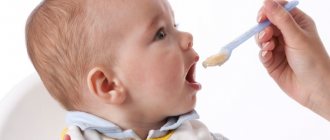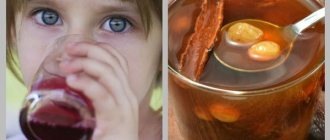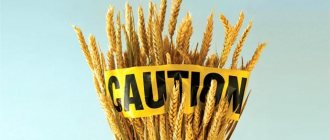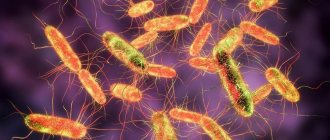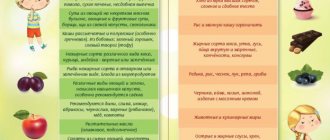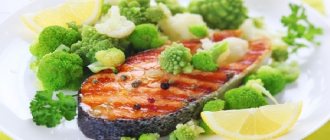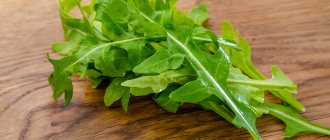General nonspecific hypoallergenic diet according to A.D. Ado
What to exclude from your diet
- Citrus fruits (oranges, lemons, grapefruit, lime, etc.)
- Nuts (hazelnuts, almonds, peanuts, etc.)
- Fish and fish products (fresh and salted fish, fish broths, canned fish, caviar, etc.)
- Poultry (goose, duck, turkey, chicken, etc.), as well as poultry products
- Chocolate and chocolate products
- Coffee
- Smoked products
- Vinegar, mustard, mayonnaise and other spices
- Horseradish, radish, radish
- Tomatoes, eggplants
- Mushrooms
- Eggs
- Unleavened milk
- Strawberries, wild strawberries, melon, pineapple
- Butter dough
- Honey
- Alcoholic drinks (strictly prohibited).
What can you eat?
- Boiled beef meat
- Cereal and vegetable soups (using recycled vegetable broth, vegetarian)
- Butter, olive, sunflower
- Porridges: buckwheat, rolled oatmeal, rice
- Lactic acid products - one-day (cottage cheese, kefir, yogurt)
- Fresh cucumbers, parsley, dill
- Baked apples
- Tea
- Sugar
- Apple compotes
- White unsweetened bread.
More often, food intolerance occurs through the mechanisms of pseudoallergic reactions, which in clinical manifestations do not differ from true allergies, but differ in the mechanisms of development. The development of pseudoallergic reactions to food products is based on the nonspecific release of mediators (mainly histamine) from allergy target cells or the excess content of histamine and tyramine in the body, caused by excessive consumption of histamine-releasing products and foods containing their excess amounts.
What is a hypoallergenic diet for nursing mothers?
The nutritional system is divided into two types: nonspecific and specific. The first type of hypoallergenic diet is indicated for nursing mothers of babies with minor manifestations of diathesis and with a high probability of developing allergies/pseudo-allergies. Women need to completely abandon all highly allergenic foods and histamine liberators (foods that do not cause reactions in the body, but enhance the synthesis of histamine, a mediator of allergies).
When a child develops moderate and severe forms of diathesis, his mother is prescribed a specific hypoallergenic diet . All histamine liberators and specific foods to which the baby is allergic should be excluded from the diet. A child's body can be sensitive to even the most low-allergenic product. To identify the irritant, a new mother needs to keep a food diary .
Foods high in biologically active amines
- Histamine: fermented cheeses, wines, sauerkraut, dried ham, beef sausages, pork liver, canned food (especially tuna, anchovy, herring fillet), smoked meats, spinach, tomatoes.
- Tyramine:
pickled cheeses: Roquefort, Brie, Camembert, Grillard, cheddar. Processed cheeses. Pickled herring. Avocado. Brewer's yeast.
!!! A strict diet must be followed, as a rule, until the manifestations of the disease disappear permanently (if the disease is not chronic), then, under the supervision of a doctor, the diet is gradually expanded.
Diet for children aged 1 to 3 years
The basis for compiling an individual elimination diet for children over one year of age is a nonspecific hypoallergenic diet - diet No. 5 GA
, which is developed on the basis of diet No. 5, intended for children with diseases of the liver and biliary system.
Products and dishes excluded, limited and allowed when prescribing diet No. 5 GA (hypoallergenic) for children
| Excluded | Limited | Recommended based on individual tolerance |
|
|
|
Must remember!!!
Unreasonably long-term use of a hypoallergenic diet for children can lead to protein-energy and micronutrient deficiency and, as a consequence, to disruption of the child’s physical development. Therefore, a strictly restrictive diet should be considered as a “starter” diet. Next, depending on the results of the examination and the identified range of causally significant products, an individual hypoallergenic diet is formed. During the period of complete or partial clinical and laboratory remission, the diet for children should be gradually expanded through individual assessment of sensitivity to certain foods with mandatory registration of allergic reactions that have occurred in a food diary.
How to eat for pregnant and nursing mothers so that children do not develop food allergies
Home Articles Popular information articles Nutrition and diets
I'm glad I have you. I want to share new sensations with you. I feel like the happiest, most wonderful, lovely woman in the world. I am loved. The sun warms me with its rays. It sends warmth and light to these trees, to the awakening grass, to the funny kitten that, waddling from paw to paw, clumsily moves around the yard. I draw energy from the sun. Strength to give to you.
Look how the buds on the tree swell and bloom. Just last week it was a dry brown branch. Now living juice flows through it. The kidneys are hardening, and I can even imagine how this happens. I feel my breasts filling with milk. It will flow to you when you are born, my baby, and will allow you to grow healthy and strong. I will enjoy it when you bury yourself in my chest and suck on me, smacking your lips. I have enough milk to feed my beloved child.
Like these buds that swell and bloom under the rays of the sun, you grow and strengthen under the rays of my and daddy’s love. I give every cell of yours what it needs. I inhale oxygen and fill every cell of your body with it. I give you nutrition, warm you with my warmth and tenderness.
I inhale deeply the aroma of spring air. I inhale its freshness and, exhaling, spread it throughout my body. I inhale power and as I exhale I transfer it to every cell of your growing body. You develop healthy, strong and robust.
I concentrate in my heart the memories of the days of happiness, when I was loved, and when I loved, and my heart trembles, warms and blooms, like a flower, the petals of which envelop you and your heart with love. I don’t hear its knocking yet, but I know that by the end of the first month it is already beating. And I know that you hear the beat of my heart, and my feelings and my attitude towards you are conveyed to you. You float there - inside the uterus, like an astronaut in a spaceship. What kind of universe surrounds you - threatening or safe, spacious or cramped, light or dark?
To make you feel better in your universe, I am learning to find a connection with everything living and growing on Earth, to feel growth and development in myself and nature. I try to live in harmony with people. I hold on to and accumulate happy experiences. Today I feel like a Creator. I feel like life is being created through me, in me, and my strength is increasing every day. First your dad, and then you helped me reveal the secret power of my body. I admire my body's ability to miraculously expand to accommodate your healthy, growing little body. It is in my power, turning to Nature and God, to give birth to a healthy child and give love and happiness to the three of us.
Nutrition for a pregnant woman
A woman expecting a child, among other things, must take care of her nutrition. As practice shows, few women listen to their doctors' recommendations about proper nutrition during pregnancy. Meanwhile, organizing proper nutrition for pregnant women is one of the important conditions for the normal course and successful outcome of pregnancy, maintaining the health of a pregnant woman and ensuring adequate growth and development of the fetus, and then the newborn child.
In this regard, the following main tasks of rational nutrition for pregnant women can be formulated:
- Satisfying the physiological needs of the fetus for basic nutrients and energy necessary for its adequate growth and development.
- Satisfying the physiological needs of a pregnant woman for the basic substances and energy necessary to maintain her health and performance.
- Ensuring a woman’s comfortable well-being, good mood and high activity at all stages of pregnancy.
The diet of the expectant mother should include proteins, carbohydrates and fats in certain quantities. First of all, a pregnant woman should pay attention to getting the required proportion of proteins, because... This is the main building material for the body, the future baby. This means that a woman needs to consume at least 200 grams of protein foods (meat, cottage cheese, chicken, fish) per day. You can also get protein by including eggs and dairy products in your diet. You need to eat one egg, 100 g of cottage cheese, 50 g of cheese and 0.5 liters of kefir per day.
The intake of the required amount of carbohydrates, vitamins and microelements will ensure the consumption of vegetables and fruits. On the day, the expectant mother needs to eat about half a kilo of raw vegetables and a little less fresh fruit. By the way, fresh fruits can be partially replaced with dried fruits or compotes made from them (homemade compotes from fresh berries and fruits). In addition, pregnant women need to receive daily vitamin F, A, E, iron, calcium, which are found in animal products.
It will be useful to take vitamin complexes, because... After all, vegetables and fruits do not fully saturate the body with vitamins. There are multivitamin complexes designed specifically for pregnant women, and specialized food products have also been developed.
Food products for pregnant and lactating women
| Product | Manufacturer | a brief description of |
| Powdered milk mixtures | ||
| Femilak | Nutritek, Russia | Dry fortified milk mixture enriched with PUFAs |
| Dumil Mama Plus | International Nutrition Co Denmark | Same |
| Enfamama | Mead Johnson, USA | Same |
| Soy based dry mixes | ||
| Milky Way | Vitaprom LLC, Russia | |
| Teas for pregnant and nursing mothers | ||
| HiPP Diana Type – Top | "HiPP", Austria "Seliko", Poland "Likub", Russia | Foreign herbal teas with the addition of medicinal herbs, fruit powders and sugars. |
In the early stages of pregnancy, women are recommended to take selenium, which is important for the development of certain body systems of the unborn child. And in the later stages of pregnancy, try to limit your consumption of sweets, grapes and watermelons. This can lead to enlargement of the fetus and complications during childbirth.
The impact of malnutrition on the development of the fetus and child
| Eating disorders | Developmental disorders of the fetus and child |
| Protein and energy deficiency | Intrauterine malnutrition (weight deficiency). Delayed brain development |
| Deficiency of polyunsaturated fatty acids | Developmental disorders of the visual system and brain |
| Folic acid deficiency in combination with vitamin deficiency. C, B6, B12. | Neural tube development defects (underdevelopment of the brain and spinal cord, cerebral hernia) |
| Vitamin A deficiency and excess | Congenital deformities |
| Deficiency of zinc, selenium | Congenital deformities, including neural tube defects |
| Iodine deficiency | Neurodevelopmental disorder |
Around the eighth month of pregnancy, include walnuts, cranberries and chokeberries in your diet; this will be useful during subsequent breastfeeding, because These products perfectly stimulate lactation. Every day a pregnant woman should receive about 3000 kilocalories.
It should be noted that one of the criteria for the correct selection of food products for nutrition of pregnant women is an increase in body weight, which in the second half of pregnancy should not exceed 300 grams per week, and for the entire period of pregnancy 10-12 kilograms.
Set of products in grams per day for a pregnant woman from 6-7 months of pregnancy: wheat bread - 120, rye - 100, wheat flour - 15, cereals and pasta - 60, potatoes - 200, vegetables -500, fruits - 300, juices - 150 , dry fruits - 20, sugar - 60, confectionery - 20, meat, poultry - 170, fish - 70, milk and fermented milk products 2.5% fat - 500, cottage cheese 9% - 50, sour cream 10% - 17, butter butter - 25, vegetable oil - 15, egg - 0.5, cheese - 15, salt - 5.
It is very important that the diets of pregnant women include a sufficient amount of dietary fiber, which stimulates intestinal motility, and thereby prevents constipation, which, as noted, often occurs in pregnant women.
It is very important to consume as much fluid as possible (up to three liters per day). Drink every hour and a half. It is best to drink tea, juices, compotes or regular purified, bottled water. And, of course, no nicotine or alcohol. Be careful with medications! Any medicine can be dangerous to the fetus, so do not take any pills unless absolutely necessary. It is best to consult a doctor about taking any medication or at least carefully study the instructions.
Nutrition for a nursing woman
Breastfeeding involves the production of significant amounts of milk by the woman’s mammary glands, containing large amounts of nutrients. To make up for these “losses,” the diets of nursing women should additionally include 30-40 g of protein, 15 g of fat, 40 g of carbohydrates, which corresponds to 450-500 kcal.
This is especially important in the first months of lactation, when the volume of breast milk can reach one liter or more. As the amount of complementary foods in the baby's diet increases (the fifth or sixth month of the child's life and older), the volume of human milk he needs decreases, and, accordingly, the mother's need for additional amounts of energy and nutrients decreases.
Recommended daily food intake for nursing mothers
| Products | Qty (g, gross) |
| Wheat bread | 150 |
| Rye bread | 150 |
| Wheat flour | 150 |
| Cereals pasta | 70 |
| Potato | 70 |
| Vegetables | 500 |
| Fruits | 300 |
| Juices | 300 |
| Dry fruits | 18 |
| Sugar | 60 |
| Confectionery | 20 |
| Meat, poultry | 165 |
| Fish | 70 |
| Milk*, kefir and other fermented milk products 2.5% fat | 600 |
| Cottage cheese 9% fat | 50 |
| Sour cream 10% fat | 15 |
| Butter | 25 |
| Vegetable oil | 15 |
| Egg, pcs. | ½ |
| Cheese | 15 |
| Tea | 1 |
| Coffee beans | 3 |
| Salt | 8 |
| * if the child has allergic reactions, replace with kefir, fermented baked milk, etc. | |
Along with the considered task - providing nursing women with a wide range of food products and, therefore, necessary nutrients, another task is to protect the baby from the adverse effects that may occur when food factors entering his body with mother's milk that can cause food intolerance, including food allergies.
If the baby's immediate family has a history of food allergies, the nursing mother needs to take into account the individuality of this allergy and use the data in this table.
It is also necessary to exclude from the diet foods with high allergic activity: peanuts, crabs, crayfish, shrimp, squid, horseradish, garlic, bee products, as well as any products that in the past caused food intolerance in a nursing woman.
A range of products recommended and not recommended for pregnant women and nursing mothers at risk of developing food allergies in their children
| Product groups | Allowed | Excluded | Excluded |
| Meat and meat products | Beef, lean pork, lamb, horse meat, rabbit, turkey, chicken, chicken* | Boiled sausages, deli meats, frankfurters, sausages no more than 2 times a week. | Raw and cooked smoked sausages; canned snack food |
| Fish and fish products* | Cod, hake, pollock, pike perch, perch | Lightly salted herring, fatty fish (flounder, halibut, sole) no more than once a week. | Mackerel, seafood (crayfish, crabs, shrimp, crab sticks), canned snack foods. |
| Eggs | — | Up to 3 pieces per week* | |
| Milk and dairy products | Fermented milk products without flavorings and fruit fillers (kefir, fermented baked milk, yoghurt, yogurt), mild cheese, cottage cheese, sour cream, goat milk, goat milk cheese | Milk, cream, fermented milk products with flavors and fruit fillings, glazed curd cheeses | |
| Cereals, pasta | Buckwheat, corn, rice, oatmeal, pasta | ||
| Bread and bakery products | Wheat, rye-wheat, bran bread, dried bread, crackers | Sweet bakery products, biscuits no more than 2 times a week | Mayonnaise, cooking fats |
| Edible fats | Refined vegetable oils: sunflower, olive, soybean; butter | Creamy margarine | |
| Sugar and confectionery | Biscuits, cookies (unsweetened), marshmallows, marshmallows | Sugar (up to 40g per day) or jam, marmalade, jams, apples, pears in equivalent quantities | Cakes, cream pies, chocolate, chocolate candies, honey, preserves, jams, jams from strawberries, citrus fruits, tropical fruits, grapes |
| Vegetables | Potatoes, cabbage, beets, zucchini, squash, cucumbers, pumpkin, carrots* | — | Tomatoes |
| Fruits | Apples, pears | Apricots*, peaches*, melon*, cherries*, sweet cherries*, currants*, plums* | Bananas, citrus fruits, tropical fruits, grapes, strawberries, raspberries, kiwi. |
| Juices and drinks, nectars | Natural, apple and pear juice; fruit drinks from cranberries and lingonberries, tea, compotes, purified or bottled water | Juices and nectars: apricot, peach, plum, cherry | Juices: tomato, orange, grape, strawberry, raspberry, cola, Schweppes, cocoa, beer, vodka and wine. |
*subject to tolerance
Heartburn in breastfeeding women usually appears suddenly, even in those who have never experienced it. She can cause a lot of trouble. The main cause of heartburn is physiological changes in the body that lead to increased gastric secretion.
In these cases, we recommend using oregano decoction and taking smecta powders.
In conclusion, I would like to note that every child is born with a good appetite. He is looking to us for guidance. And our main task is to help him understand the world of a huge variety of tastes and choose his own, right path. In childhood, a health program is laid for many years. At an early age, taste habits are formed.
Our health directly depends on what we eat. Of course, proper nutrition is not a panacea for all ills, nor is it the only recipe for well-being, but it is a real chance to start wisely, maintain and prolong life. Remember the truth: love cannot be spoiled!
(The article uses materials from the methodological recommendations of the Moscow Government Health Committee).
Author: gastroenterologist of the highest category V.L. Zemlyakov.
Pediatric Consultative Center of Academician L.A. Dulkin Leading gastroenterological center in the Chelyabinsk region. Tel. to sign up for a consultation: 89026187717
Source : Pediatric Consultative Center of Academician L.A. Dulkin Print version


